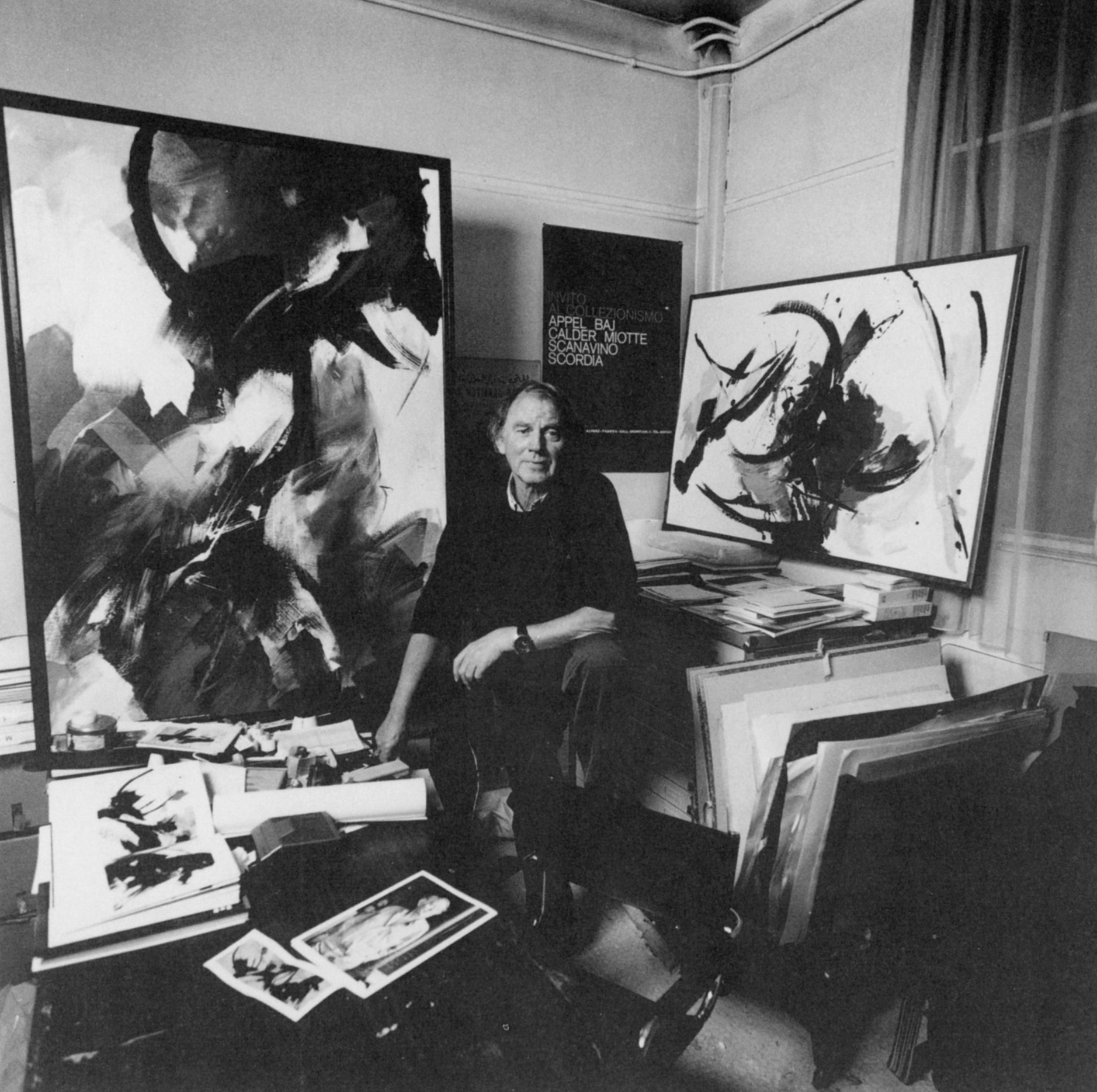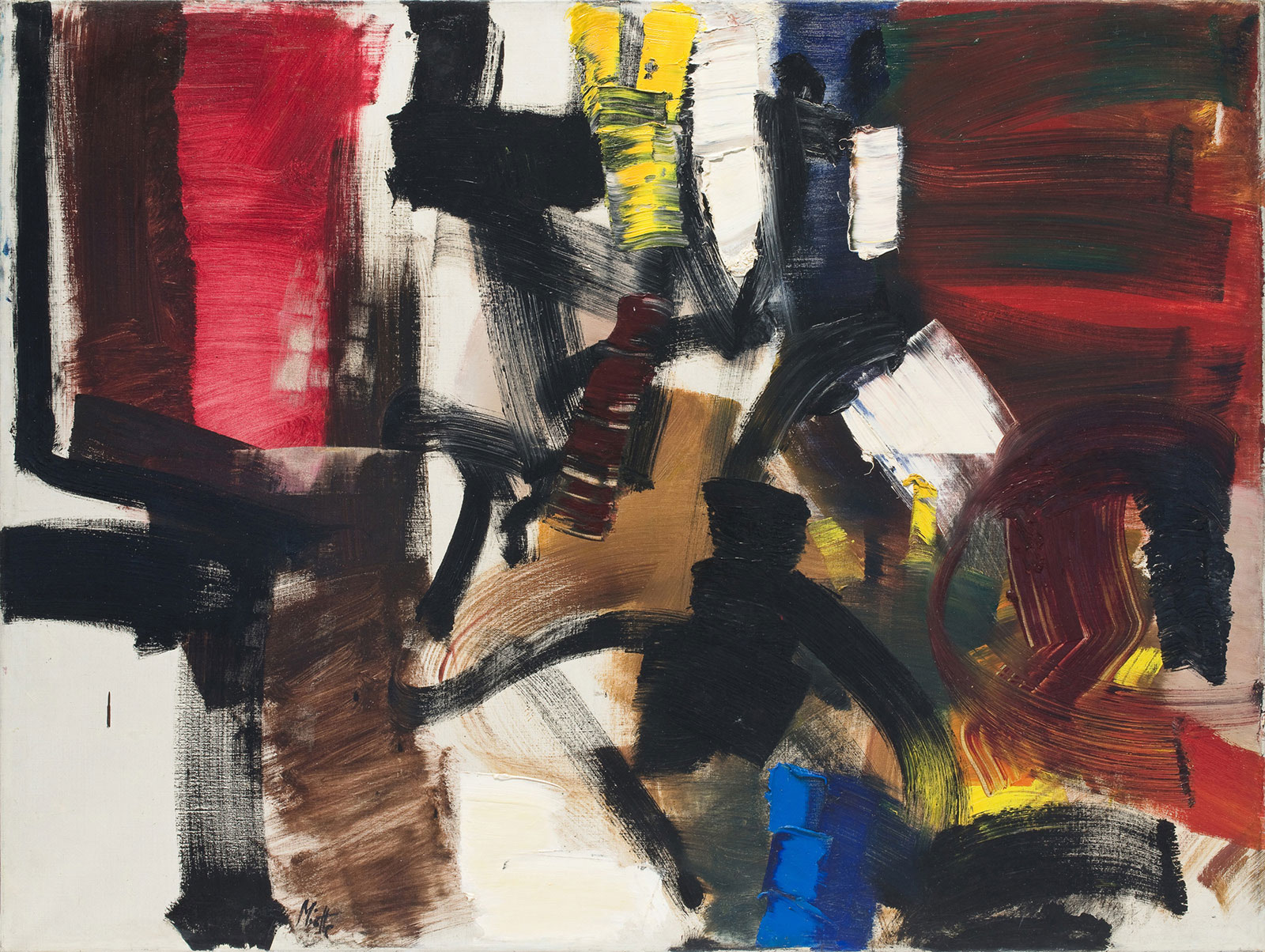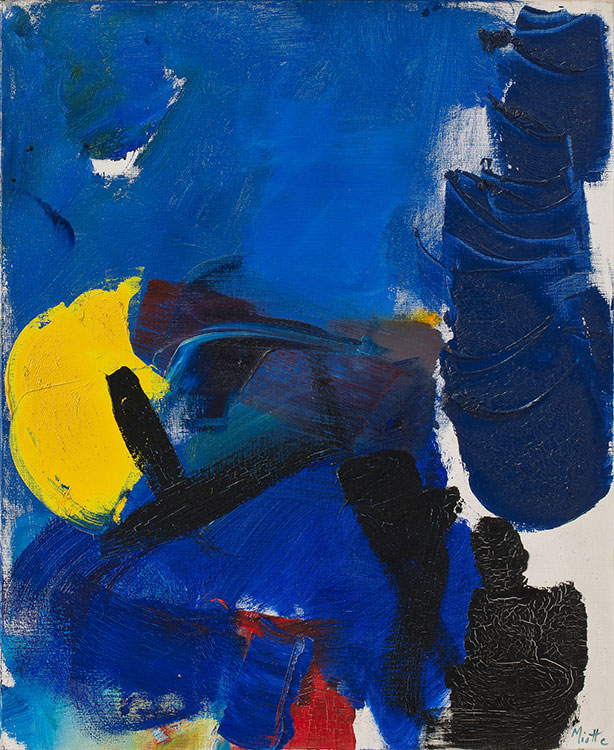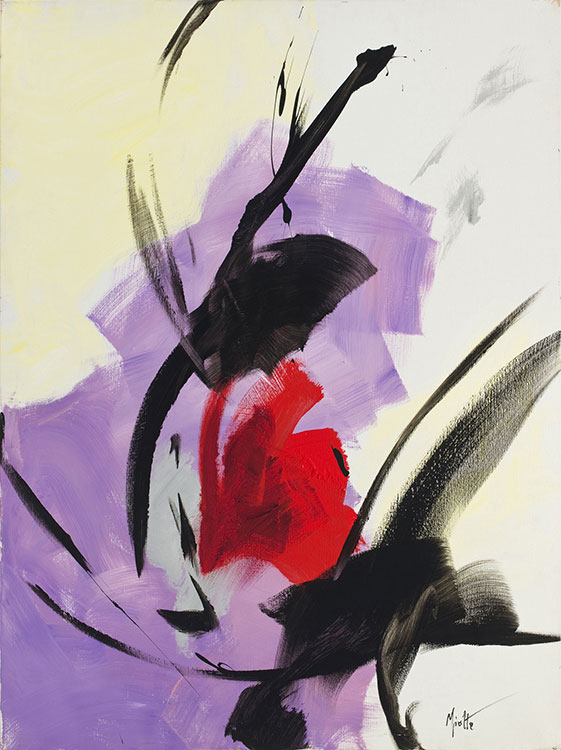JEAN MIOTTE
Exhibition from June 3 to July 3, 2021
JEAN MIOTTE
Painting and Movement
YOUTH AND EDUCATION OF THE PAINTER JEAN MIOTTE
Jean Miotte was born in Paris in 1926 and spent his youth in Occupied Paris. After studying mathematics, Jean Miotte discovered painting during his military service in 1946. He painted the walls of the barracks. In 1947, to finish his training in art, Jean Miotte went to the studio of the Fauve painter Émile Othon Friesz, and then to Ossip Zadkine, the Cubist painter and sculptor. Jean Miotte was also greatly impressed by Fernand Léger’s work. The Cubist artists in fact had an important influence. Just as his predecessors decomposed to recompose, Miotte “unmakes”. Jean Miotte, was “the orchestration of a world that explodes”1. The artist was at the time fascinated by the depiction of the body and learned to draw it while moving.
THE IMPORTANCE OF DANCE IN JEAN MIOTTE’S ART
Jean Miotte was surrounded by friends who were dancers and choreographers such as Zizi Jeanmaire and Wladimir Skouratoff. Skouratoff brought him to London to see performances of Colonel Basil’s ballet company. The prima ballerina of the Ballets du Marquis de Cuevas, Rosella Hightower, invited Jean Miotte to Monte-Carlo where he designed theatre sets. For Jean Miotte : “Some quite funny adventures started there, which began in the dance world. (…) I savoured the first marvels and discoveries of the choreographic world, the arabesque, the scenic organization of the line, the rhythm…” Jean Miotte’s first figurative paintings often show dancers. Following on from Edgar Degas, for Jean Miotte this subject was the perfect pretext for showing movement.
Jean Miotte created his first abstract works around 1950. Gradually, the figure was dissolved in the arabesque. The artist’s gesture was spontaneous, it was an improvised dance with the canvas. His painting was his gesture, the brush and palette knife tracing his movement. Painting and painter moved at the same speed like a reflection. Jean Miotte was carried by “something sacred in the energy of life”.2
GESAMTKUNSTWERK
Jean Miotte’s painting was nurtured by theatre and performance. The artist dreamed of a synthesis of music, painting and choreography, following on from Richard Wagner’s theories about the Gesamtkunstwerk or total work of art. This concept aims to associate several forms of art to fuse art and life together. Jean Miotte followed this idea perfectly in treating his biographical experiences as a spectator of ballet as if it were an art school. This was a creative visual experience, in the same way as passing through the studio of a great painter. The critic Roger van Gindertaël referred to Jean Miotte’s painting as “of total harmonisation in the tension of life itself with all its complexities and contradictions.”
1 – Miotte, E, Karl Ruhrberg, 1998, La Différence, Paris
2 – Jean Miotte, Francis Spar, Connaissance des Arts, n°41, november 1963
Richard Wagner’s ideas of the 19th century again became topical in the 20th due in part to the activities of the Black Mountain College. This independent experimental university was established in 1933 in North Carolina. It prioritised avant-garde artistic practices. In 1952, John Cage organized an event there, identified as the first “happening” in the history of art. For 45 minutes, several different artistic activities happened freely and at the same time: David Tudor played the piano, Mary Caroline Richards and Charles Olson read poems, Robert Rauschenberg projected films on the ceiling, John Cage read a lecture and Merce Cunningham danced. This event happened in a décor comprised of white monochromes by Robert Rauschenberg and a black and white abstract painting by Franz Kline.
Jean Miotte, who was sensitive to American culture, was fascinated by these concepts, bringing together art and life. Still in 1952, Jean Miotte met the American painter Sam Francis and visited his studio in Ville-d’Avray (France). The exhibition Cinquante Ans d’Art aux États-Unis (Fifthy years of Art in the US) was shown in 1955 at the Musée d’Art Moderne de Paris and then in 1959, the same museum organized the exhibition Jackson Pollock et la nouvelle peinture américaine (Jackson Pollock and the new American painting).
In 1958, the dealer Jacques Dubourg gave Jean Miotte a contract at the same time as Jean-Paul Riopelle, Sam Francis and Joan Mitchell. In 1961, along with Sam Francis, Georges Mathieu and Jean-Paul Riopelle, Jean Miotte was included in the group exhibitions of the Galerie Swenska-Franska in Stockholm and the Galerie Bonnier in Lausanne. That year, he was awarded the Ford Foundation Prize and was invited to spend six months in the USA. The following year, a solo show of his work was organized by the Iolas Gallery in New York. Jean Miotte met the American artists Robert Motherwell, Mark Rothko, Chaïm Jacob Lipchitz and Alexander Calder. He travelled around the USA and gave a lecture at Colorado Spring University.
In 1972, he again spent time in the USA, this time in New York and Washington. Forty-six of his canvases were exhibited at the International Monetary Fund in Washington. In 1978, Jean Miotte set up his studio in New York where he was represented by the Martha Jackson Gallery. The Guggenheim Museum acquired two of his works on paper in 1987. The Jean Miotte Foundation opened in New York in 2002 with a permanent collection of his works.
MOVEMENT IN VISUAL ART
Jean Miotte fit perfectly into the artistic context of the second half of the 20th century where movement became important in painting with Lyrical Abstraction, Action Painting, Kinetic Art, Abstract Expressionism, performance and so on. This interest was doubtless initiated by Marcel Duchamp with Anemic Cinema¸ an experimental film from 1926 in which optical disks whirl for seven minutes.
Jean Miotte’s paintings were created with an immediate gesture, a dazzling motion. “Movement is my life” he recalled. In this, he can be compared to Jackson Pollock. Jean Miotte never prepared his work with sketches. The American art critic Harold Rosenberg appreciated this practice especially : “the most important thing in art is freshness”. This free and instinctive form of painting was also influenced by Surrealism. The spirit was liberated of all constraints of reflection : “it is the intuition that counts above all when a work is born”. Jean Miotte evoked his work as the “result of internal conflicts, my painting is a projection; a succession of acute moments where creation happens in full spiritual tension. Painting is not a speculation of the mind or the intellect, it is a gesture that is carried within.” Jean Miotte met Roberto Matta who told him : “Surrealism is for me a battle. (…) You too, you are a fighter, you are like me, your paintings are not abstract.” Surrealism also played a fundamental role in the development of American Abstract Expressionism, in particular due to the presence in the USA of Roberto Matta and Marcel Duchamp.
Jean Miotte received a commission from the city of Paris : a large format work titled Sud which hangs in the main hall of the Bastille Opera House. The writer Castor Seibel wrote about Jean Miotte’s painting : “Beyond all realistic figuration, it is an event in itself that finds its expression in the gestural dynamic and its equivalence in colour… knowing how to combine the contradictory in the form seems possible for Miotte, serenity battles chaos, gentleness and the savage rub shoulders in happiness.”
The painter Jean Miotte is fundamentally a man of his time for his artistic priorities based on movement, at a time when performance became a new medium of creation. The movement of the painter, his tools, his subjects, spectators and even artworks became an essential element in the art of the second half of the 20th century.

Jean Miotte in his studio, Vitry-sur-Seine, 1993
Photo : Droits réservés
EXHIBITED ARTWORKS

COMPOSITION ABSTRAITE – 1955 ca.
Oil on canvas
130 x 89 cm – 51 1/8 x 35 in.
Signed “Miotte” lower left
Galerie Diane de Polignac, Paris

MOUVEMENT D’AMITIÉ – 1955 ca.
Oil on canvas
55 x 65 cm – 21 5/8 x 25 5/8 in.
Signed “Miotte” and titled “Mouvement d’amitié” on reverse
Galerie Diane de Polignac, Paris

UNTITLED – 1958
Oil on canvas
97 x 130 cm – 38 3/16 x 51 3/16 in.
Signed “Miotte” lower left
Galerie Diane de Polignac, Paris

COMPOSITION – 1960
Oil on canvas
62 x 50 cm – 24 3/8 x 19 3/4 in.
Signed “Miotte” lower right, signed and dated “Miotte 60” on reverse
Galerie Diane de Polignac, Paris

ESPÉRANCE – 2008
Acrylic on canvas
97 x 130 cm – 38 3/16 x 51 3/16 in.
Signed “Miotte” lower right, signed and dated “Miotte 2008” on reverse
Galerie Diane de Polignac, Paris

SEUL AVEC TOI – 2010 ca.
Acrylic on canvas
130 x 97 cm – 51 3/16 x 38 3/16 in.
Signed “Miotte” lower right
Galerie Diane de Polignac, Paris

TOUT PRÈS DE TOI – 2010
Acrylic on canvas
130 x 97 cm – 51 3/16 x 38 3/16 in.
Signed “Miotte” lower right, signed and dated “Miotte 2010” on reverse
Galerie Diane de Polignac, Paris
SELECTED COLLECTIONS
Berlin, Graphotek
Castellon, Museo de Arte Contemporáneo de Villafamés
Cologne, Museum Ludwig
Dortmund, Museum am Ostwall
Dhaka, National Museum of Bangladesh
Dunkirk (France), Musée d’Art Contemporain
Hamburg, Staats-und Universitätsbibliothek Hamburg Carl von Ossietzky
Maassluis (Netherland), Gemeentemuseum
Munich, Staatsgalerie Moderner Kunst
New York, The Solomon R. Guggenheim Museum
New York, The Museum of Modern Art
New York, The Chelsea Art Museum
Paris, Musée d’Art moderne de la Ville de Paris
Paris, Bibliothèque Nationale
Paris, Ministère des Affaires culturelles
Paris, Opéra national Bastille
Paris – La Défense, Fonds national d’art contemporain (FNAC)
Paris – La Défense, Fondation d’Art contemporain CNIT
Rio de Janeiro, Museo de Arte moderna
Saarbrucken (Germany), Saarlandmuseum, Moderne Galerie
Singapore, National Museum of Singapore
Taichung, Taiwan Museum of Arts
SELECTED EXHIBITIONS
Salon des Réalités Nouvelles, Paris, 1953. Participated regularly from this date on
Exposition d’ouverture, Galerie du Haut du Pavé, Paris, 1954
50 ans d’art abstrait, to coincide with the publication of Dictionnaire de la Peinture abstraite by Michel Seuphor, Galerie Creuse, Paris, 1957
Galerie Lucien Durand, Paris, 1957
Réalités nouvelles, nouvelles réalités, 13e salon des Réalités Nouvelles, Kunsthalle de Recklinghausen, Recklinghausen (Germany), 1958
Cinq peintres de Paris : Bogart, Bysantios, Jousselin, Miotte, Mihailovitch, Galerie Attico, Rome, 1958
Section Informel: Hains, Miotte, Neiman, Foldes, Favory…, First Paris Biennale, Paris, 1959
15 peintres de Paris, Kolnischer Kunstverein, Cologne, 1959, 1962
Ouverture, Galerie Flinker, Paris, 1960
Ouverture, Galerie Iris Clert, Paris, 1960
Galerie Am Dom, Frankfurt, 1960
Galerie Gunar, Düsseldorf, 1960
Exposition Internationale, Museum Wolfram Von Eschenbach, Wolframs-Eschenbach (Germany), 1961
Sam Francis, Mathieu, Miotte, Riopelle, Galerie Swenska Franska, Stockholm, 1961
Galerie Bonnier, Lausanne, 1961
Drian Gallery, London, 1961
Centre Culturel de Mechelen, Mechelen (Belgium), 1961, 1976
Galerie Iolas, New York, 1962
Galerie Jacques Dubourg, Paris, 1963
Stedelijk Museum, Schiedam (The Netherlands), 1963, 1967
Musée de Groningen, Groningen (The Netherlands), 1963
Galerie Zodiaque, Brussels, 1963
Grand Palais, Paris, 1963, 1988
Cobra et l’Informel : Appel, Constant, Corneille, Miotte, Riopelle, Tal Coat, Galerie Krikhaar, Amsterdam, 1965
Galerie Dierks, Aarhus (Denmark), 1966, 1968, 1971
Court Gallery, Copenhagen, 1966
Galerie Bio, Aalborg (Denmark), 1967
International graphies, The Corcoran Gallery of Art, Washington DC, 1970
Galerie Wünsche, Bonn, 1970, 1974, 1976
Septentrion, Centre artistique de la Fondation A. Prouvost, Marcq-en-Baroeul (France), 1970
Huit Peintres de Paris : Abboud, Debré, Karskaya, Messagier, Moser, Miotte, Nalard, Rebeyrolle, Maison de la Culture, Bourges, 1971
International Monetary Fund, Washington DC, 1972
Galerie Dinastia, Lisbon, 1972
Prudhoe Gallery, London, 1973, 1974
Galerie Winter, Braunschweig (Germany), 1975, 1978
Galerie Nieuwe Weg, Doorn (The Netherlands), 1976, 1979, 1984, 1991
Cinq artistes : Appel, Baj, Calder, Miotte, Scordia, Galerie Alfiere, Padoue, 1976
Bishops Gallery, Melbourne, 1977
Damascus Cultural Center, Damas, 1978
National Museum, Alep, 1978
Amman Cultural Center, Amman, 1978
Musée de Dunkerque, Dunkirk, 1978, 1993
L’Abstraction des Années 50 en France, Maison de la Culture, Grenoble (France), 1978
L’Abstraction des années 50 en France, Musée de Saint-Omer, 1978
Travelling retrospective in French cultural centres, 1979
Beijing Cultural Center, Beijing: First exhibition of a western artist in the People’s Republic of China, 1980
Galería Lucas, Gandía (Spain), 1980, 1981
Galerie Koppelmann, Leverkusen (Germany), 1980, 1983
Centre Culturel, Montpellier (France), 1980
Ayala Museum, Manilla, 1981
Musée de la Poste, Hamburg, 1981
Evergreen Galleries, The Evergreen State College, Olympia, Washington D.C, 1982
Hong-Kong Arts Center, Hong-Kong, 1982
French Japanese Institute of Tokyo, Tokyo, 1982
Trevisan Galleries, Edmonton (Canada), 1982
Paris 59 : Fautrier, Feraud, Hartung, Lanskoy, Lipsi, Miotte, Schneider, Sonderborg, Soulages, TaI Coat, Tapies, Galerie Koppelmann, Cologne, 1982
National Museum of Singapore, Singapore, 1983
National Museum of History, Taipei, 1983
Bitran, Chu teh-Chun, Hartung, Miotte, Soulages, Chapelle des Franciscains, Saint-Nazaire (France), 1983
Galerie La Cité, Luxembourg, 1983, 1987
Striped House Museum, Tokyo, 1984
Vik Gallery, Edmonton (Canada), 1984
French Institute of Athens, Athens, 1984
Deux peintres, deux sculpteurs, Orangerie de Bagatelle, Paris, 1984
Opus Gallery, Miami, 1985
Konstmassan, Stockholm, 1985, 1989
Art Atrium, Stockholm, 1985
Columbia University, New York, 1986
Galerie Keeser, Hamburg, 1987, 1989, 1991
Les Peintres autour d’Arrabal, Musée d’Histoire, Esch-sur-Alzette, Luxembourg, 1987
Ciae, Chicago International Art Exhibition, Chicago, 1987
Colloque Euro-Arabe, National Museum of Malta, Malta, 1987
Art in Paris, Pavillon Inter-Continental, Singapore, 1987
Galerie Gimpel & Weitzenhoffer, New York, 1988
Galerie Egelund, Copenhague-Holte, 1988, 1990
Espace d’Art Contemporain E. Ungaro, La Rochelle, 1988
Rencontres écrites, Institut du Monde Arabe, Paris, 1988
Les années 50 : Benrath, Chu teh-Chun, Debré, Dietrich Mohr, Féraud, Hartung, Lanskoy, Miotte, Music, Père, Pichette, de Staël, Subira Puig, Casino de Hyères, Hyères (Frane), 1988
Les années 50, Mécénat Pernod, Paris-Créteil, First venue of a travelling exhibition, 1988
Galerie N’namdi, Detroit, 1989
Miotte/Arrabal, Maler und Dichter, French Institute of Hamburg, Hamburg, 1989
Galerie von Braunbehrens, Munich, 1990, 1992, 1996
Galerie Wild, Frankfurt, 1990, 1992, 1994, 1997
Abstrakte Malerei nach 1945: Miotte, Noël, Schumacher, Sonderborg, Thieler, Haus Sandreuther, Riehen-Basel, 1990
Art et Partage, Musée des Beaux-Arts, Nice, 1990
Musée Seibu, Tokyo, 1991
Galerie Jade, Colmar, 1991, 1992
Galerie Michael Schultz, Berlin, 1991, 1993, 1997
Mémoire de la Liberté : 55 artists from 23 countries, César, Sam Francis, Miotte, Rauschenberg, Motherwell, Lichtenstein, Tinguely, Tapies, etc., illustrate each article of the Universal Declaration of Human Rights, organized by the Association France Liberté, Centre Pompidou, Paris, 1991
Collections des collections ; de Paul Klee à nos jours, CNIT, Fondation d’Art Contemporain, Paris-La Défense, 1991
Couleurs de la vie, international travelling exhibition of contemporary art under the patronage of Mme Danielle Mitterand, Bibliothèque Nationale, Paris, 1991
Forms of Abstraction, N’namdi Gallery, Birmingham, Michigan, 1991
Palais des Arts, Toulouse, 1992
Galerie Shuyu, Tokyo, 1992
Galerie Saint-Polly, Gunrua (Japan), 1992
Art and Art, Nicaf 92, Yokohama, 1992
Grands formats, Miami Art Fair, Miami, 1992
Art Multiple, Düsseldorf, 1992, 1994
5 artistes des années 50 : Christophorou, Debré, Miotte, Féraud, Koch, Centre Culturel Jean Despas, Saint-Tropez, 1993
Hartung et Miotte, Ishi Gallery, Osaka, 1993
Musée des Cordeliers, Châteauroux, 1994
Œuvres graphiques, Musée Bertrand, Châteauroux, 1994
30 ans Après : Sam Francis, Jean Miotte, Joan Mitchell, Jean-Paul Riopelle, organized by Chapel Art Center, Hamburg and Cologne, 1994, 1995, 1997
Pour la paix et la reconstruction au Liban – 33 peintres, Musée Sursock, Beirut, 1994
Chinesische Kunst nach 1945 in Europa – Eine Gegenüberstellung : Li Di, Chu teh-Chun, Zao, Rétrospective 1956-1996, Musée Mücsarnok, Budapest, 1996
Les années 1945-1975, Maison de l’Unesco, Paris, 1996
Arrabal, der Lyriker und die Künstler, Dali, Dorny, Miotte, Saura, Gutenberg Museum, Mayence (Germany), 1996
The Garner Tullis Donation, The Ackland Art Museum, Chapel Hill, NC, 1996
Museum Am Ostwall, Dortmund (Germany), 1997, 1999, 2000
Ont-ils du métier ? Propositions pour l’art vivant – Agam, Boltansky, César, Claisse, Cruz. Diez, Hains, Honegger, Messager, Miotte, Morellet, Nemours, Soto, Tinguely, Vasarely, Venet…, Galerie Denise René, Paris, 1997
Grenzganger (qui traversent la frontière) : Sandro Chia, lan Hamilton Finlay, Markus Lüppertz, Jean Miotte, A.R. Penck, Bernd Zimmer, for the 200th anniversary of Heinrich Heine, Kunsthalle Düsseldorf, Staatsgalerie Stuttgart, Goethe institut Paris and Marseille, Villa Romana, Florence, 1997
20 ans d’exposition, Museum Haus Ludwig für Kunstausstellungen, Saarlouis, 1997
Arbeiten auf Papier (works on paper), Kunstmarkt Dresde, Dresde, 1997
The National Arts Club, New York, 1998
Van Der Togt Museum, Amsterdam-Amstelveen, 1998
Villa Haiss, contemporary art Museum, Zell A.H. (Germany), 1998, 2000
Musée d’Art et d’Histoire, Fribourg (Switzerland), 1999
Museum Ludwig, Koblenz (Germany), 2000
Aboa Vetus Ars Nova Museum, Turku (Finland), 2000
Museum of Brno (Czech Republic), 2002
Chelsea Art Museum, New York, 2003, 2005
Museo Fundacion Cristóbal Gabarrón, Valladolid (Spain), 2005
Artrium, Geneva, 2005
Bibliothèque nationale de Nice, Nice, 2005
Jean Miotte, Galerie Diane de Polignac, Paris, 2019
SELECTED BIBLIOGRAPHY)
Michel Seuphor, Dictionnaire de la peinture abstraite, Paris: Fernand Hazan, 1957
Galleria Attico, exposition collective avec Bogart, Byzantios, Jousselin, Mihailovitch, Rome, 1958
Kunstverein, exposition collective : Sam Francis, George Mathieu, Jean Miotte, C Maussion, Jean-Paul Riopelle, Cologne, 1962
Maison de la Culture de Bourges, Exposition collective : Karskaya, Debré, Abboud et autres, Bourges, 1972
Michel Ragon, Histoire de l’art abstrait, vol. IV, Paris: Maeght editions, 1975
José-Augusto França, Castor Seibel, Miotte, La Porte Verte, 1975
Chester Himes, Miotte, coll. « L’art se raconte », Palaiseau: SMI editions, 1977
French Institute of Athens, Écriture et signes, text by Jean Miotte, Athens, 1984
Gérard Xuriguera, Les années 50, Paris: Arted editions, 1985
Fernando Arrabal, Jean Miotte, Devoirs de vacances, été 85, Paris: Galilée editions, 1986
Marcelin Pleynet, Miotte, Œuvres sur papier 1950-1965, Paris: Galilée editions, 1987
Marcelin Pleynet, Miotte, Paris: la Différence editions, 1987
C.M Cluny, Miotte, Peintures et Gouaches, coll. « L’Autre Musée », Paris: la Différence editions, 1989
M Chelbi, L’affiche d’art en Europe, Saint Romain au Mont d’or: Van Wilder editions, 1989
Jean-Luc Chalumeau, Miotte, coll. « Passeport », Paris: Fragment editions, 1990
Bohbot, Miotte, Le Geste majeur, Paris: Navarra editions, 1991
Centre Georges Pompidou, Mémoire de la liberté exhibition catalog, Paris, 1991
Jean-Claude Lambert, Le règne imaginal, coll. « Diagonales », Paris: Cercle d’Art, 1992

Jean Miotte in his studio, 1992
Galerie Diane de Polignac
2 bis, rue de Gribeauval – 75007 Paris
www.dianedepolignac.com
Textes – texts: Mathilde Gubanski
Traduction – translation: Lucy Johnston
© Œuvres : ADAGP, Paris, 2021
Photographies des oeuvres : Droits réservés
© Artworks: ADAGP, Paris, 2021
Photographs of the works: Reserved rights
© Galerie Diane de Polignac, 2021
